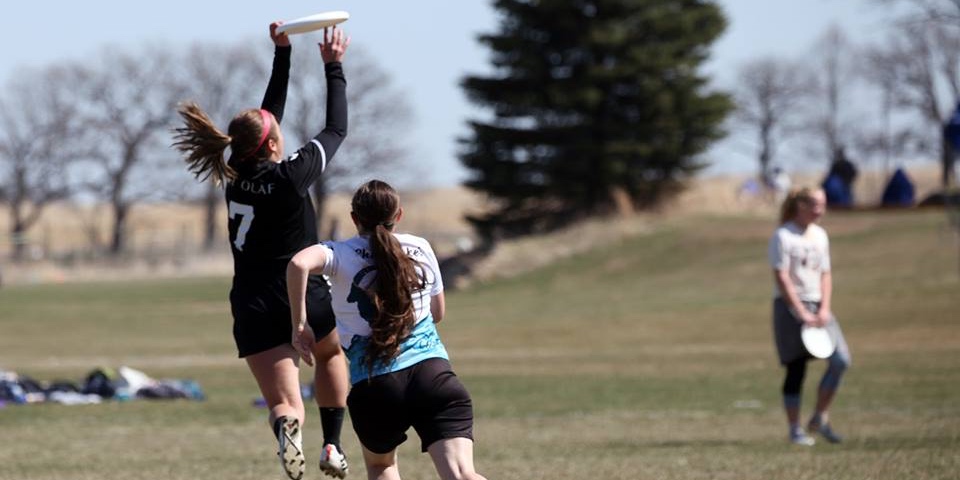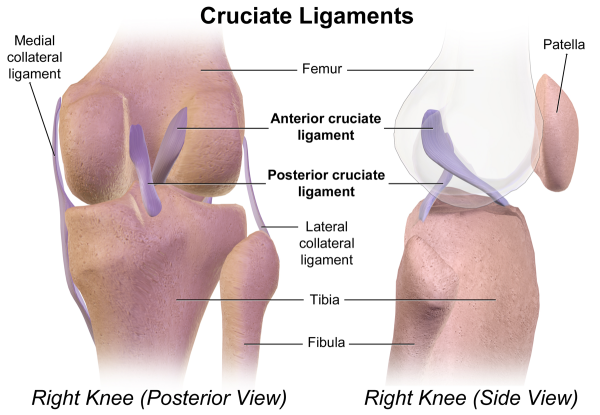 Photo by Cathy Zielske
Photo by Cathy Zielske
Concepts and Causes
Ultimate is plagued with knee injuries. I haven’t found any research to let me know what fraction of players have experienced a knee injury, but we all know it’s too high. And for the players affected, it’s not a fractional injury in any way. It’s easily a season-ending injury that may also linger through future seasons. As coaches, we have an ethical obligation to give proper instruction to keep our athletes safe and healthy.
First, it’s important to understand what happens during a knee injury, specifically ligament strains. Disclaimer: I’m not a medical professional, so I’m going to be vague enough that none of them will disagree with me. Don’t ask me to diagnose your knee pain.
Whenever we run, jump, land, or cut, we are putting force into the ground. Our muscles are pushing down from our hips, to our thighs, to our calves, into the ground to either push us off or slow our descent. If they are in alignment, that force directly transfers into the ground. If they are not, it’s similar to backing a truck with a trailer that starts forming an angle. Energy spills out to either side. Unfortunately, our joints don’t have as much leniency as a trailer hitch, and even a small angle can cause serious damage. Often this results in tearing of the ligaments at the knee that hold the bones in place.
We do have some protection mechanisms. Our muscles will try to pull at precisely the right amount to keep our knee in perfect alignment. However, muscles need to be trained to become reliable. In addition to just making them stronger, they have to know how to react to uneven forces quickly and confidently to bring the knee into alignment. We have proprioceptors in the muscles that sense the positioning of the muscles and joints, and they need to be trained to work effectively. As a last resort, we have cruciate ligaments connecting our femur to our tibia.

Image by BruceBlaus / CC-BY-SA-4.0
Athletes coming off an anterior or medial cruciate ligament (ACL or MCL) injury have severely limited use of their proprioceptors. Trainers often prescribe exercises that slowly build these up, and eventually add strength components, then reactive components. We can take our cue from these professionals, and adapt the same exercises to strengthen our knees and prevent the injuries from happening in the first place. “Prehab” is really just rehab exercises with a more progressive load.
Preventative Exercises
Squats
The most straightforward way to teach our knee to align is to explicitly put it in alignment in a slow and controlled fashion. Squats are the way to go. It’s great to do it under a barbell, but even body weight squats and squat jumps can teach athletes how to get into the correct position from their heads to their toes. Even in something as simple as this stress good form, as a squat without good form is less helpful than no squats at all.

Balance
Our first step to aligning ourselves over one leg is to create a good sense of balance. We can’t expect to properly absorb multiples of our body weight into the ground unless we can reliably hold it in place. We only need to hold these for 5-15 seconds per leg, but we do need to be in control of our position through the whole exercise. Here are some ideas.
- Single-leg (SL) balance
- SL balance with quarter squat
- SL balance with eyes closed
- SL deadlift
- SL deadlift with controlled opening and closing of hips
- SL disc tossing
As you can see, there are a variety of ways to progress each exercise so that everyone is challenged.
Single-leg hops
Single-leg hops test and train our knees’ ability to react to the ground and align itself upon landing. I do these in singles, so each hop is a chance to mentally focus on landing, and collecting your weight above your leg without your knee caving in. I usually start with around four repetitions per leg, eventually letting players choose their level of comfortability/difficulty. Here is a list of varieties in order of difficulty.
- In place
- Forwards and backwards
- Laterally
- With rotation
- With increasing height
- Multiple hops
Deceleration
Decelerations provide multiple, less-stressful points to absorb force through our legs. You can increase intensity by building up speed going into the deceleration and by shortening the deceleration distance. Proper form is still crucial in this exercise, so emphasize dropping the hips to absorb force through hips and thighs rather than knees. Make sure knees are aligned, and to use multiple choppy steps, rather than few hard stomps.
These exercises also create a good foundation to start more advanced plyometrics (a future topic). It’s important to be vigilant in observing your athletes, and also have them be aware of their own bodies. If they feel pain, they need to tell you, take a break, and likely adjust what they’re doing. If you notice an athlete struggling to stick a landing with good form, you need to offer them a regressed version of the exercise. We all need to work hard to give all of our players an unimpeded season.
Further reading:
- Plyometric Anatomy by Derek Hansen and Steve Kennelly
- Jumping into Plyometrics by Donald Chu
- https://breakingmuscle.com/fitness/how-split-cleans-and-snatches-strengthen-your-acl










Comments Policy: At Skyd, we value all legitimate contributions to the discussion of ultimate. However, please ensure your input is respectful. Hateful, slanderous, or disrespectful comments will be deleted. For grammatical, factual, and typographic errors, instead of leaving a comment, please e-mail our editors directly at editors [at] skydmagazine.com.